2015 Sea-Doo Spark Review
Low buck PWC returns after successful first year
It’s baaaaaaack!
Yup, the most affordable, most innovative personal watercraft to come along in years returns for 2015, and perhaps the most amazing part about the 2015 version of the Sea-Doo Spark is that it has resisted the seemingly inevitable price creep to maintain its $4,999 starting price.
Read our review of the 2015 Yamaha VX and V1 Lineup
So just what do you get for the money? Let’s take a refresher course on all things Sparky.
Innovative Hull
By now, most people have at least seen the Spark. It’s cutting edge in design, but there’s more to it than just style. That colorful, matte-look finish, available in all those mouth-watering colors? It’s trendy, but it’s primarily the result of BRP not using fiberglass for the Spark’s hull and deck, but instead developing a proprietary material dubbed PolyTec. Actually polypropylene strengthened with long-strand glass fibers, it’s much lighter in weight than fiberglass, yet still plenty durable. That gaping open space up front? It’s part of the boat’s “Exoskel” system. By using an internal, wishbone-style frame up front, BRP engineers created a cool, one-of-a-kind look, reduced materials (which ultimately shaved off both pounds and dollars), and yet maintained plenty of rigidity.
And then there’s the boat’s unique hull-deck joint. Rather than adhesive, the Spark’s two halves are sandwiched around a rubber gasket seal, and then bolted together. A consumer’s everyday access is kept ultra minimal. The fuel fill is under the saddle, and both the battery and oil dipstick are accessed through small ports, spaces through which an owner can also spray some anti-corrosion product on the engine if desired. But from a consumer standpoint, that’s pretty much it. Dealer service technicians, however, can unbolt the entire top deck in about 10 minutes and remove it completely from the hull. The result is the kind of wide-open access to the engine, fuel system and driveline that is last seen during factory assembly.
Small Engine, Big Power-to-Weight Ratio
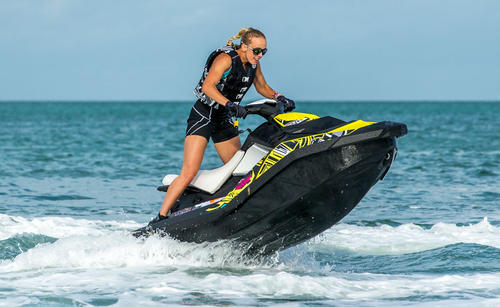 Thanks to its light weight, the Spark’s relatively small engine has no trouble providing a fun ride.
Thanks to its light weight, the Spark’s relatively small engine has no trouble providing a fun ride.The idea behind much of the hull technology, of course, is to reduce not just cost but weight. A dramatically lighter craft (the base Spark weighs in at a mere 405 pounds) can use a dramatically smaller, lighter, lower horsepower engine. In the case of the Spark that powerplant is the 900cc Rotax ACE, a design actually co-developed with Ski-Doo engineers for a snowmobile project. It’s a mere 60 hp in the base model, but that’s still good enough to push the boat to a top speed of about 40 mph. Option up to the 90 hp version – an upgrade I’d strongly suggest for all but the most conservative riders – and you’ll push that top speed closer to 48 mph, as well as significantly improve the low-end punch. The 90 hp version also brings with it the familiar Sea-Doo Touring and Sport modes, meaning you can choose a tamer ride with greater fuel economy, or a more spirited ride with a little more get-up-and-go.
A common question is whether or not the Spark is adequate for towing duties. The short answer is yes. In its three-up configuration (the option includes a longer saddle and nicely integrated hull extension), the Spark can handle basic tubing and boarding. Just don’t expect the ultimate ride. Sea-Doo makes WAKE models (as well as just about every other three-passenger boat in the line) that do that sort of stuff much better. Still, it’s possible to handle the basics, and that only adds to the Spark’s versatility.
Old-School Handling
Though the Spark can handle more, it’s ideally suited for smaller bodies of water and an old-school, playful riding style. It’s actually meant to evoke an old-school SP. Hammer the throttle in a straight line, then chop it as you quickly flick the bars and you’ll launch into the classic powerslide. Or, unweight the back end, throw your weight forward and crank the bars, and you can spin the boat on its nose. In short, it’s fun to just goof around on like we used to do way back when, the sort of riding that’s all but impossible with most of today’s models.
Read our comparison of the 2014 Sea-Doo GTS 130 vs. Sea-Doo Spark
Still, the Spark can carve with the right rider input. Yes, it’s still much looser than all of today’s more hard-cornering styles, but if you plant your outside foot toward the stern to keep things locked in and crank it into a turn, it will snap off a pretty good corner, especially with the added power of the 90 hp upgrade. In some ways, it can feel a little like the Yamaha WaveBlaster of old, certainly not a bad comparison given that boat’s avid fan base.
And yes, plenty of hardcore riders have already taken Sparks far beyond those “calmer, inland lakes and waterways.” Those up for the challenge will find the Spark can actually be a fun ride in rougher conditions, especially when those conditions include some jumpable waves.
Customization Potential
Not content with the basic Spark? As previously mentioned, you can stretch it to a three-passenger model via the hull extension, or boost power to a more potent 90hp engine. But you can also customize the boat’s looks. A wide variety of stick-on graphic kits are available to make the Spark stand out even more. Owners can also add practical upgrades like a seven-gallon front storage, flip-down boarding step designed to rest a knee on to facilitate deep-water reboarding, and even Sea-Doo’s Intelligent Brake and Reverse system. Yes, iBR adds to the cost of a boat designed to keep costs in check, but it’s sure handy for maneuvering around tight areas – like the dock and launch ramp – and it offers stopping power should you need to slow abruptly out on the water.
News and Notes
A year of use has certainly brought a few issues to light. One concern is that it’s difficult to spray down the interior of the engine compartment thanks to the mostly closed design. BRP would encourage owners to use the few access ports to reach into the interior, especially for those who ride in salt water. There were also some early problems with the handlebar and steering column durability in rough conditions, but it was traced to a manufacturer Sea-Doo sourced parts from and handled with a recall.
Read our comparison of the Kawasaki STX-15F vs. Sea-Doo GTS 130 vs. Yamaha VX Sport
It’s also interesting to note that, according to sources at another manufacturer, the “average” sales price for a Spark was well into the $7,000 range, meaning consumers frequently optioned up from the $4,999 base model.
But in the end, the Spark pretty much did just what Sea-Doo hoped – light a little bit of a fire underneath a stagnant industry. The 2014 model run sold out early, and even the competition had to note the model’s positive influence. Will that momentum continue into 2015? Probably so, at least to some extent. There’s a certain pent-up demand from those unable to get a Spark in 2014, as well as likely a greater acceptance of the model in general. My main disappointment with the Spark for 2015 is that Sea-Doo didn’t refresh or add some color choices, a la the colorful, refreshed Apple iMacs of years back.
But that’s just nitpicking.
| 2015 Sea-Doo Spark Specs | |
| Length | 110 inches (two-passenger)/120 inches (three-passenger) |
| Beam | 46 inches |
| Dry Weight | 405 lbs (two-passenger)/421 lbs (three-passenger) |
| Engine | Three-cylinder four-stroke, normally aspirated |
| Displacement | 899 cc |
| Rated Horsepower | 60/90 |
| Fuel Capacity | 7.9 gal. |
| Combined Stowage Capacity | 0.42 gal (glovebox)/7.42 gal (w/optional front storage bin) |
| Passenger Capacity | 2/350 lbs; 3/450 lbs |
| Colors | Orange Crush, Pineapple, Bubble Gum, Vanilla, Licorice |
| Price | Starting at $4,999 |
Get PersonalWatercraft.com in your Inbox!
Like PersonalWatercraft.com on Facebook
Comments
Most Popular

2025 Yamaha JetBlaster PRO 2-Up Review

Remembering the Sea-Doo XP

2024 Kawasaki Jet Ski STX 160X Review

2017 Kawasaki Jet Ski Ultra 310LX Review

Whatever Happened to the Wetbike?




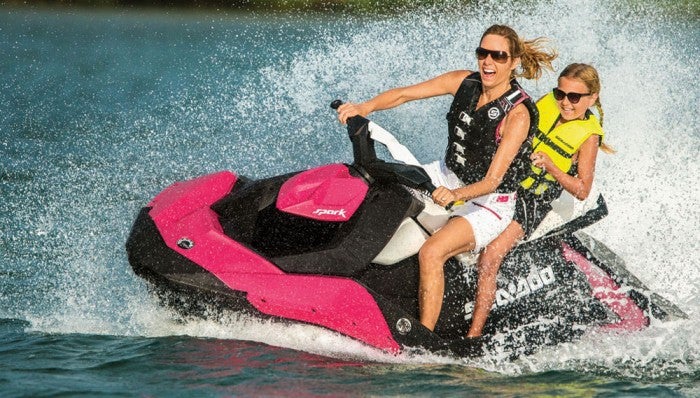
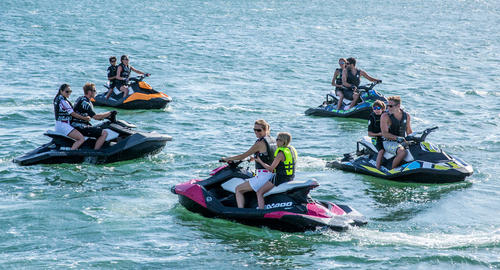
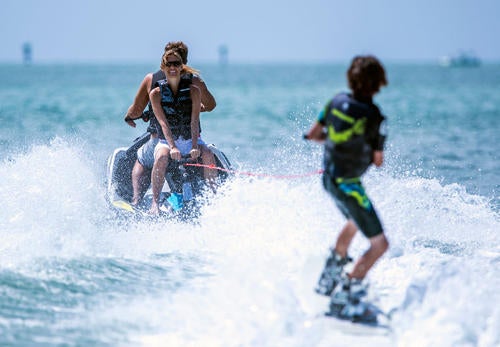

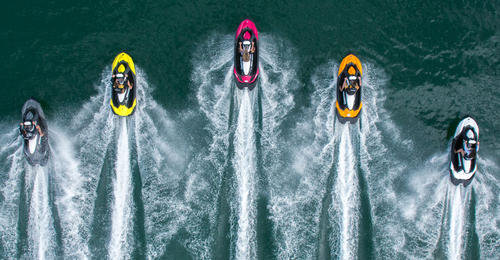
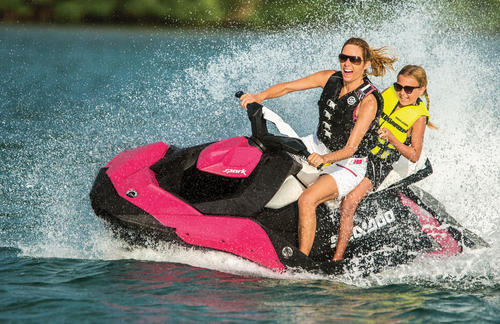









 Your Privacy Choices
Your Privacy Choices